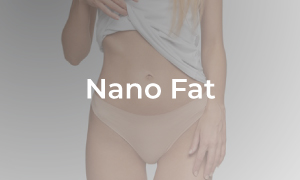Nano Fat
In fat grafting, autologous fat (fat harvested from the patient’s own body) is used to provide structural augmentation in different body regions such as the face, breasts, and buttocks. Autologous fat graft contains numerous fat cells and these cells remain viable after transplanted to the target areas.
In nanofat, on the other hand, fat cells are disintegrated and emulsified into liquid form which is then injected into various target areas. Nanofat contains no viable fat cells but has abundant viable adipose-derived stem cells (ADSCs) and various tissue growth factors released from the disintegrated fat cells. The combination of stem cells and tissue growth factors produces positive trophic changes in the skin and underlying tissues, improving and enhancing skin tone, texture, and elasticity. Compared with other stem cell–based therapies, harvesting and processing of nanofat is relatively cost-effective as it requires no special laboratory devices or culturing time. Since nanofat is in liquid form, it can be injected into superficial layers of the skin using microneedling technique. The regenerative capacity of nanofat has been proven in various applications, such as reducing hypertrophic scars and promoting wound healing. Nanofat offers many advantages as a technique for skin repair and rejuvenation. Nanofat uses the patient’s own fat, a completely natural material without any added chemicals or artificial ingredients. The whole procedure is simple and safe with very low risk of complications. Recovery is rapid and downtime is short.
The primary use of nanofat is to improve the quality of the skin. The main applications of nanofat include:
-
-
-
To improve fine wrinkles on the face.
-
To treat pigmentation conditions such as dark eye circle and mottled skin complexion.
-
To treat scar problems such as acne scarring, hypertrophic scars and atrophic scars.
-
-
Preparation
-
Inform the doctor of any pre-existing medical conditions and drug allergy. All medical conditions must be treated and stabilized before surgery.
-
Stop smoking at least one week before surgery. Smoking is harmful to wound healing and increases the risks of other post-operation complications.
-
Stop the following medications and supplements from one week before surgery until one week after surgery.
-
All supplements containing vitamin E, ginseng, ginkgo, garlic, fish oil, and other ingredients that increase bleeding during the procedure. Other supplements, traditional medicine, and herbs, in which ingredients are unknown, have to stop as well.
-
Medicine that increases bleeding during the procedure such as aspirin, NSAIDs, and warfarin. However, you may need to consult your physician who prescribed the medication before you stop them.
-
-
On the day of surgery, wear simple and comfortable clothing. Do not wear any makeup. Do not wear any jewelry and metal objects on the face and body.
Procedure
Duration: 1-2 hours
Anaesthesia: Local anaesthesia
Hospitalization: not required
Recovery*: Back to work in 1-3 days, light exercise after one week, heavy exercise after 4 weeks. *The actual speed of recovery depends on the site and extent of the fat grafting and may vary from person to person
Technique: Fat is harvested from donor site using a special liposuction cannula. Common donor sites are tummy and thigh. The fat is washed, filtered and emulsified into liquid form. This liquid form end product is we called the nanofat. Nanofat is injected into various target areas using very fine needles to ensure precise and atraumatic delivery into targets areas.
Post-operative Care**
-
What to expect: Swelling usually is very minimal. Downtime one to two days.
-
General care:
-
Avoid direct pressure and hot contact on the target areas.
-
Avoid smoking for at least one month. Smoking may interfere with the effects and results of nanofat.
-
Adequate rest and sleep are helpful for a speedy recovery.
-
Be relaxed and calm. Contact the clinic if there are any queries.
-
-
Medicine: Finish the oral antibiotics as prescribed. Take the painkiller as prescribed when necessary.
-
Wound care: The fine needles leave no wounds at the target areas. No dressings are required.
-
Physical activity: Avoid heavy physical activity and exercise for at least one week.
-
Follow-up: Come back one week after surgery for suture removal and review.
-
Emergency: If there is heavy bleeding, a rapid increase in swelling or severe pain, immediately contact the clinic/doctor for advice.
** The instructions in this list are only for general guidance. If you have any specific queries or concerns during the post-operative recovery, please contact the clinic for further advice.






